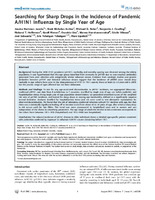Please use this identifier to cite or link to this item:
http://sgc.anlis.gob.ar/handle/123456789/400| DC Field | Value | Language |
|---|---|---|
| dc.contributor.author | Hartman Jacobs, Jessica | es |
| dc.contributor.author | Archer, Brett Nicholas | es |
| dc.contributor.author | Baker, Michael G. | es |
| dc.contributor.author | Cowling, Benjamin J. | es |
| dc.contributor.author | Heffernan, Richard T. | es |
| dc.contributor.author | Mercer, Geoff | es |
| dc.contributor.author | Uez, Osvaldo | es |
| dc.contributor.author | Hanshaoworakul, Wanna | es |
| dc.contributor.author | Viboud, Cécile | es |
| dc.contributor.author | Schwartz, Joel | es |
| dc.contributor.author | Tchetgen Tchetgen, Eric | es |
| dc.contributor.author | Lipsitch, Marc | es |
| dc.date.accessioned | 2012-11-24T02:14:54Z | - |
| dc.date.available | 2012-11-24T02:14:54Z | - |
| dc.date.issued | 2012 | - |
| dc.identifier.issn | 1098-5336 | - |
| dc.identifier.uri | http://sgc.anlis.gob.ar/handle/123456789/400 | - |
| dc.description | Fil: Hartman Jacobs, Jessica. Harvard School of Public Health. Department of Epidemiology; Estados Unidos. | es |
| dc.description | Fil: Archer, Brett Nicholas. National Health Laboratory Service. National Institute for Communicable Diseases; Sudáfrica. | es |
| dc.description | Fil: Baker, Michael G. University of Otago. Department of Public Health; Nueva Zelanda. | es |
| dc.description | Fil: Cowling, Benjamin J. The University of Hong Kong. School of Public Health; China. | es |
| dc.description | Fil: Heffernan, Richard T. Wisconsin Department of Health Services. Division of Public Health; Estados Unidos. | es |
| dc.description | Fil. Mercer, Geoff. Australian National University. National Centre for Epidemiology and Population Health; Australia. | es |
| dc.description | Fil: Uez, Osvaldo. ANLIS Dr.C.G.Malbrán. Instituto Nacional de Epidemiología; Argentina. | es |
| dc.description | Fil: Hanshaoworakul, Wanna. Ministry of Public Health. Department of Disease Control; Tailandia. | es |
| dc.description | Fil: Viboud, Cécile. National Institutes of Health. Division of International Epidemiology and Population Studies; Estados Unidos. | es |
| dc.description | Fil: Schwartz, Joel. Harvard School of Public Health. Department of Epidemiology; Estados Unidos. | es |
| dc.description | Fil: Tchetgen Tchetgen, Eric. Harvard School of Public Health. Department of Epidemiology; Estados Unidos. | es |
| dc.description | Fil: Lipsitch, Marc. Harvard School of Public Health. Department of Epidemiology; Estados Unidos. | es |
| dc.description.abstract | BackgroundDuring the 2009 H1N1 pandemic (pH1N1), morbidity and mortality sparing was observed among the elderly population; it was hypothesized that this age group benefited from immunity to pH1N1 due to cross-reactive antibodies generated from prior infection with antigenically similar influenza viruses. Evidence from serologic studies and genetic similarities between pH1N1 and historical influenza viruses suggest that the incidence of pH1N1 cases should drop markedly in age cohorts born prior to the disappearance of H1N1 in 1957, namely those at least 52–53 years old in 2009, but the precise range of ages affected has not been delineated.Methods and FindingsTo test for any age-associated discontinuities in pH1N1 incidence, we aggregated laboratory-confirmed pH1N1 case data from 8 jurisdictions in 7 countries, stratified by single year of age, sex (when available), and hospitalization status. Using single year of age population denominators, we generated smoothed curves of the weighted risk ratio of pH1N1 incidence, and looked for sharp drops at varying age bandwidths, defined as a significantly negative second derivative. Analyses stratified by hospitalization status and sex were used to test alternative explanations for observed discontinuities. We found that the risk of laboratory-confirmed infection with pH1N1 declines with age, but that there was a statistically significant leveling off or increase in risk from about 45 to 50 years of age, after which a sharp drop in risk occurs until the late fifties. This trend was more pronounced in hospitalized cases and in women and was independent of the choice in smoothing parameters. The age range at which the decline in risk accelerates corresponds to the cohort born between 1951–1959 (hospitalized) and 1953–1960 (not hospitalized).ConclusionsThe reduced incidence of pH1N1 disease in older individuals shows a detailed age-specific pattern consistent with protection conferred by exposure to influenza A/H1N1 viruses circulating before 1957. | es |
| dc.format | application/pdf | ES |
| dc.language.iso | en | es |
| dc.publisher | Yes | es |
| dc.relation.ispartof | Plos one | es |
| dc.rights | info:eu-repo/semantics/openAccess | en_US |
| dc.rights | Creative Commons Attribution 4.0 International License | - |
| dc.rights.uri | http://creativecommons.org/licenses/by/4.0/ | - |
| dc.source | PloS One 2012; 7(8): e42328. | en_US |
| dc.subject | Orthomyxoviridae | es |
| dc.subject | Virus de la Influenza A | es |
| dc.subject | Subtipo H1N1 del Virus de la Influenza A | es |
| dc.title | Searching for sharp drops in the incidence of pandemic A/H1N1 Influenza by single year of age | es |
| dc.type | Artículo | es |
| dc.identifier.doi | 10.1371/journal.pone.0042328. | - |
| anlis.essnrd | 1 | es |
| item.languageiso639-1 | en | - |
| item.grantfulltext | open | - |
| item.openairecristype | http://purl.org/coar/resource_type/c_18cf | - |
| item.fulltext | With Fulltext | - |
| item.cerifentitytype | Publications | - |
| item.openairetype | Artículo | - |
| crisitem.author.dept | Instituto Nacional de Epidemiología (INE) | - |
| crisitem.author.parentorg | Administración Nacional de Laboratorios e Institutos de Salud “Dr. Carlos G. Malbrán” (ANLIS) | - |
| Appears in Collections: | snrd Publicaciones INE | |
Files in This Item:
| File | Description | Size | Format | |
|---|---|---|---|---|
| PloSOne,2012,7(8),e42328.pdf | Artículo en inglés | 2.42 MB | Adobe PDF |  View/Open |
Page view(s)
264
checked on Dec 23, 2025
Download(s)
125
checked on Dec 23, 2025
Google ScholarTM
Check
Altmetric
Altmetric
This item is licensed under a Creative Commons License


